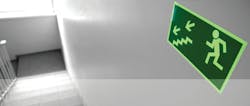Most security and safety executives are familiar with the national fire alarm and signaling code, released and updated regularly by the National Fire Protection Association (NFPA) and better known as NFPA 72. However, there are other NFPA codes which are not as readily recognized. One of those codes, NFPA 101, which is often referred to as the “Life Safety Code,” should be required knowledge for anyone installing or overseeing an electronic access control system.
NFPA 101 is focused on the safety of individuals within a building. This means that both employees and visitors should be able to exit safely, with the easy operation of any exit door release.
There are different requirements for special environments such as nursing homes, correctional facilities, etc., but overall it is important to remember that the Authority Having Jurisdiction (AHJ) can add requirements. Because the code is updated every three years, the exact code year selected by each municipality will vary. It is therefore important to review any new access control plans with the AHJ prior to implementation.
NFPA 101 requirements are in place to facilitate a safe environment. Safety will often be at odds with security — meaning it is important to understand the codes so that a well thought-out plan is in place to provide both safety and security. Below are general issues associated with NFPA 101 and how they impact various areas and doors of a facility and the electronic access control systems.
Stairwells
The impacts of NFPA 101 on stairwells are numerous. Obviously for safety reasons, it is important to allow free access into and out of a stairwell on many floors of a building, including the lobby for first responders; however, some of these entrances to the stairwell on different floors may be locked for security purposes – i.e., to restrict access. To meet code in buildings of more than four stories, there must be access from the lobby into the stairwell, and access to at least two floors with not more than four floors locked in between. The top floor or next-to-the-top floor must also remain unlocked from inside the stairwell. Additionally, signage must be in the stairwells indicating which floors are unlocked and which are not. These requirements can be a major concern for a security manager that does not want access to floors from a stairwell enclosure in a building.
Lobby stairwell access can actually be a serious security concern, if access to floors above is restricted to the general public. Technology approaches include: alarming the lobby stairwell door; adding video surveillance coverage; providing the lobby receptionist with a clear view of the stairwell door; and/or to use plants, planters and other blockades to minimize undesirable access to the door.
Stairwell doors at each floor are the second major concern. If it meets the guidelines above, certain stairwell doors can be locked or secured with card readers to restrict access; however, to meet code, all doors must have a pushbar or panic release that enables stairwell entry.
The third concern is access to the roof. If the stairwell allows roof access, code dictates that it must be unlocked if it does not allow re-entry from the roof itself. From a security standpoint, the easiest way to handle roof access is to keep the roof access point locked inside the building going out, which restricts access, but enables one to enter the stairwell from the roof. As a security safeguard, an alarm on the roof door is a minimum, with motion detection and video coverage added as necessary.
Fire Doors
One area that must be understood by the security team is the difference between an emergency exit door and a fire door. In essence, either can be an emergency exit door; however, the primary difference is that the fire doors must have mechanical closures and push bar fire exit hardware that cannot be dogged open. The doors will be required to meet a fire rating based on code requirements and they cannot be modified in any way that reduces the fire rating, such as drilling large holes in it.
Code says that all fire door hardware must also be approved for the same fire rating, which often means the fire door is ordered as a complete fire door assembly including the fire exit hardware.
Emergency Door Releases and Closing Mechanisms
Delayed Egress: According to the code, opening an emergency exit door must be accomplished with a single releasing operation that is obvious to any user and may not exceed 15 pounds of effort or more than three seconds to release the latch. The release device must be mounted 34 to 48 inches above the floor.
To minimize security issues, a delayed egress “controlled panic egress” device on exterior doors that use panic-type door release mechanisms is often deployed. This allows a delay before the door latch release and provides an audible alarm. For example, an emergency exit door on the side of a building or pedestrian dock door often incorporates a delayed egress device. With delayed exit, the maximum delay time is 15 seconds (the AHJ can approve up to 30 seconds).
In buildings protected throughout by an approved automatic fire sprinkler system that is supervised, the door must unlock upon activation of the sprinkler system (water flow), any heat detector or up to two smoke detectors. NFPA 101 limits this automatic unlocking to areas of low occupancy and ordinary hazard contents. Usually, delayed exit devices require pre-approved door hardware from one of several different manufacturers. The hardware generally builds in the functionality to comply with NFPA 101. The only additional requirement from a security standpoint is to have the door alarmed, as an audible alarm will discourage abuse of the emergency exit.
NFPA 101 also requires signage that indicates the alarm will sound and the door will release in the AHJ-approved number of seconds. From a security perspective, additional wording should be added that tell the user that an alarm is being sent to the security department.
Self-Closing Devices: Another type of door hardware is a self-closing device, which is required on fire door assemblies. Typically, when a sprinkler system water flow or smoke detector activates, these doors — usually located in the middle of a hallway — automatically close. They are held open by an electrically-powered “hold open” device, where the electrical power is automatically shut off and activate mechanical closure when there is a water flow or smoke detection alarm. The primary impact on the electronic access control system is that these doors cannot be used as part of the overall building access control.
Electronically-Controlled Egress
NFPA 101 expects all electronically controlled access doors to be fail-safe to assure egress. In other words, when power fails or the possibility of a fire is detected, these doors will allow free egress, which by definition can allow free access.
This loss of a secure perimeter door can be an acceptable level of security in fire emergency situations only. If higher security is needed, such as in Sensitive Compartmented Information Facility (SCIF) areas, special hardware can be installed that enables panic door hardware release when the alarm system is off, but does not allow free entry.
If a magnetic lock is used in the access control system, electrical power must be removed from the magnetic lock when fire is detected. This applies to all security-controlled doors that are part of a fire egress route. In small, normally unoccupied areas such as equipment rooms, a motion detector or pushbutton adjacent to the door can be used as a means of releasing the exit door’s electromagnetic lock. This approach should be approved in advance with the AHJ, because even though it complies with the letter of the code, the AHJ still may not approve it.
Robert Pearson has written numerous articles and has recently published a book titled, “Electronic Security Systems.” On a day-to-day basis he oversees design, project management, and maintenance of security systems for multiple sites.
About the Author

Robert Pearson
Robert Pearson holds a BSEE and is a Registered Professional Engineer. He has been an instructor at George Washington University, teaching “Integrated Security Systems” and “Corporate Security Management.” He has written numerous articles for various technical magazines and has recently published a book, “Electronic Security Systems.” On a day-to-day basis he oversees design, project management, and maintenance of security systems for multiple sites. He is a member of A/E National Standing Council for ASIS International.
